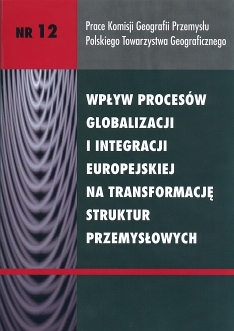Impact of globalization and regional integration within MERCOSUR on the transformation of the Brazilian automobile industry in the years 1990–2006
DOI:
https://doi.org/10.24917/20801653.12.5Keywords:
globalizacja, integracja, MERCOSUR, przemysł samochodowyAbstract
The aim of this paper is determining the influence of the globalization and regional integration processes on the Brazilian automobile industry. The paper also contains the analysis of changes in the state’s industrial policy towards this sector and their influence on winning new foreign investments. The analysis also concerns changes in the MERCOSUR integration policy towards the automobile industry. It was observed that the changes that occurred in the Brazilian automobile industry in the years 1990-2006 are to a large extent a consequence of world-wide transformations in the sector, caused by globalization. On one hand, the changes consisted in modernizing the existing plants, and on the other hand - in emergence of completely new enterprises that aimed at global expansion on the so-called rising markets. This led to the increase in production, diversification of the assortment of available models, and the increase in competition on the Brazilian market.As for integration policy, the member states tried to postpone as long as possible complete liberalization of products trade in this industry within MERCOSUR. Owing to this, they were able to conduct individual policies in this sector, on one hand trying to maintain the barriers that protected their domestic markets, and on the other hand, trying to offer as much as possible to attract foreign investors. This led to numerous conflicts and great tension, chiefly between Argentina and Brazil, which endangered the process of economic integration. Still, the emerging problems were successfully overcome and the barriers for automobile industry trade within MERCOSUR were gradually eliminated. It was reflected in the rapid increase in car trade between the two countries in years 2003-2006.Downloads
Metrics
References
Amann E., Haddad E., Perobelli F., Guilhoto J., 2007, Structural Change in the Brazilian Automotive Industry and Its Regional Impact, „Latin American Business Review”, vol. 7, no. 3–4, s. 97–119
Anuário da Indústria Automobilística Brasileira ediçăo 2007, 2007, Associaçăo Nacional dos Fabricantes de Veiculos Automotores – ANFAVEA, Săo Paulo (http://www.anfavea.com.br/anuario.html)
Baer W., Cavalcanti T., Silva P., 2002, Economic integration without policy coordination: the case of Mercosur, „Emerging Markets Review”, vol. 3, s. 269–219
Brazilian Autoparts Industry Performance 2007, 2007, SINDIPEÇAS, ABIPEÇAS, Săo Paulo. (http://www.sindipecas.org.br)
Cason J., 2000, On the Road to Southern Cone Economic Integration, „Journal of Interamerican Studies and World Affairs”, vol. 42/2, s. 23–42
Foreign Investment in Latin America and the Caribbean 1998, 1999, United Nations Economic Commission for Latin America and the Caribbean (ECLAC), Santiago de Chile
Foreign Investment in Latin America and the Caribbean 2003, 2004, United Nations Economic
Commission for Latin America and the Caribbean (ECLAC), Santiago de Chile
Gomez Mera L., 2005, Explaining Mercosur’s Survival: Strategic Sources of Argentine–Brazilian Convergence, „Journal of Latin American Studies”, no. 37, s. 109–140
Gomez Mera L., 2007, Macroeconomic Concerns and Intrastate Bargains: Explaining Illiberal Policies in Brazil’s Automobile Sector, „Latin American Politics and Society”, vol. 49, no. 1, s. 113–140
Humphrey J., 2003, Globalization and supply chain networks: the auto industry in Brazil and India, „Global Networks”, vol. 3, no. 2, s. 121–141
Laplane M., Sarti F., 2000, Profit strategies in MERCOSUR: adaptability to changing conditions as a key factor for competition in unstable markets, „Actes du GERPISA”, no. 29, s. 10–20
Laplane M., Sarti F., 2003, Profit Strategies and National Growth Model in Developing Countries: the case of MERCOSUR, 11-th GERPISA International Colloquium, Paris
Manzetti L., 1990, Argentine–Brazilian Economic Integration: An Early Appraisal, „Latin American Research Review”, vol. 25, no. 3, s. 109–140
MERCOSUR Report no. 6 1999–2000, 2000, Inter-American Development Bank, Integration and Regional Programs Department, Institute for the Integration of Latin America and the Caribbean (INTAL), Buenos Aires
MERCOSUR Report no. 7 2000–2001, 2001, Inter-American Development Bank, Integration and Regional Programs Department, Institute for the Integration of Latin America and the Caribbean (INTAL), Buenos Aires
MERCOSUR Report no. 11 2005–2006, 2006, Inter-American Development Bank, Integration and Regional Programs Department, Institute for the Integration of Latin America and the Caribbean (INTAL), Buenos Aires
O’Keefe T.A., Haar J., 2001, The Impact of MERCOSUR on the Automobile Industry, The North–South Agenda, Paper 50, North–South Center University of Miami
Rodriguez-Poze A., Arbix G., 2001, Strategies of waste: bidding wars in the Brazilian automobile sector, „International Journal of Urban and Regional Research”, vol. 25/1, s. 134–154
Queiroz S., Carvalho R.Q., 1999, Recent developments in Brazilian autovehicle and components trade: building the space of production in MERCOSUL, „Actes du GERPISA”, no. 25, s. 65–75
Tigre B.P., Laplane M., Lugones G., Porta F., 1999, Technological change and Modernization in the MERCOSUR Automotive Industry, „Integration and Trade”, no. 7–8, s. 123–145, Institute for the Integration of Latin America and the Caribbean (INTAL), Buenos Aires
Żuławska U., 2003, System gospodarczy Ameryki Łacińskiej, WGiSR, UW, Warszawa
Downloads
Published
How to Cite
Issue
Section
License
Articles are published under the terms of the Creative Commons License (CC BY-ND 4.0; Attribution– NoDerivs).

